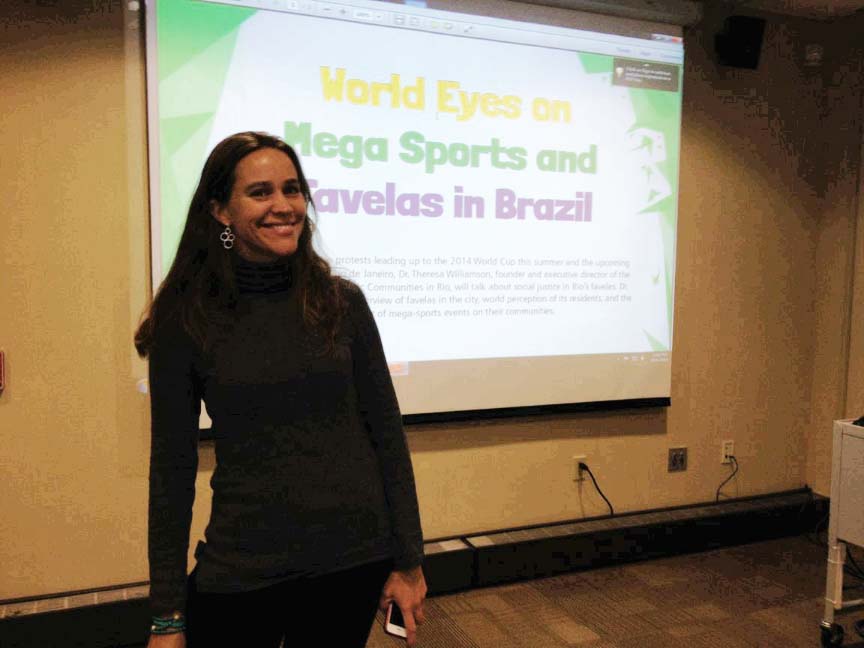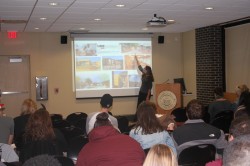
By DANIEL FEINBERG and CANDACE MITCHELL
A visiting Brazilian activist and scholar discussed the transformation Rio’s favelas are currently undergoing as the city prepares for the 2016 Olympics, and the efforts of her website, RioOnWatch, to bring more visibility to issues in these communities, including police brutality, escalating prices and the evictions of thousands of families.
In her Nov. 6 lectures, Dr. Theresa Williamson, a Ramapo Schomburg scholar, discussed with students the impact that stories told by favela residents via Rioonwatch and social media have had in countering stigmas surrounding the hillside communities. At Ramapo, Schomburg scholars bring diverse perspectives on international issues to campus.
“There was a huge opportunity to bring visibility to these local perspectives,” said Williamson, who is currently touring U.S. campuses, during her talk at Ramapo College. “At the time, this was a resource or tool where communities in Rio could document what was happening in their community.”
Williamson, founder and executive director of Catalytic Communities, a non-governmental advocacy group, launched RioOnWatch, a website she refers to as “an Olympic experiment,” as a community solutions database to document and expose the truth about the happenings in the favelas. The exposure from this website has led to an increase and a change in media discourse surrounding favelas, an increased awareness of favela gentrification and a change in the city’s strategies.
“The goal is not to simply publish news or get readers. The articles are read by major media outlets and they are about getting a better understanding of the city,” Williamson said.
[SOUNDSLIDES: Dr. Theresa Williamson discusses the general perception of favelas.]

RioOnWatch, a hyperlocal website, eventually gave national exposure to these favelas by involving mass media. International media outlets began moving to Rio, including The New York Times, NPR and BBC.
“We saw that international media were setting up in Rio. This was a critical rebranding of the city,” said Williamson. “This confirmed for us the power of combining local documentation and international exposure.”
The transformation from local news to national news gave exposure to issues in the favelas, including police occupations of favelas, high unemployment rates, escalating prices and the displacing and eviction of traditional residents. RioOnWatch put favelas on the radar and major media outlets noticed.
“We’ve always had an interesting relationship with the media that in the beginning was unintentional,” said Williamson.
Website covers favela culture, human rights issues
This project began as part of as a final dissertation for Williamson’s doctorate. Published in both English and Portuguese, the website’s goal is to deliver hyperlocal local news to the people of Rio de Janeiro throughout the process of the city becoming the home of the 2014 World Cup and the 2016 Summer Olympics.

Caitlin Stedge-Stroud
Sections of the website include blogs, favela culture, human rights, gentrification and a series about military police in Rio. The four part series tracks the history of police action and violence, going as far back as 1808 when the Portuguese royal family of Braganza moved to Rio de Janeiro.
Part 4 of the series, entitled “Pacifying Police Units,” tracks the decrease in violence by police. According to this part of the series, “police killings in the state have decreased from a record high of 1,330 in 2007 to 415 in 2012.”
However, violence by police began to grow during protests when citizens became upset with the governmental spending for the two sporting events.
“Protestors experienced police violence,” Williamson said. “But with the website (RioOnWatch), the broader society knows what the police is capable of.”
The experiment was largely an attempt to change the stigma surrounding favelas. An estimated 24 percent of Rio’s residents live in 1,000 favelas.
“Most people and newspapers translate favelas to slums and we’re trying to change that,” said Williamson.
Through research, they found that 64 percent of respondents who hadn’t been to Rio’s favelas, but who had heard of them say their impression is unfavorable. However, Williamson did not find this negative imagery to be accurate, prompting her to bring more visibility to the communities.
Students who attended the event took away a different perspective about favelas.
“She related a lot of what she was talking about to the community journalism in the favelas, and how it impacted on a global scale,” said Alyssa Nathanson, a student of global communication and media.
“When I started visiting favelas I had a very different impression,” said Williamson. “I came out of favelas inspired and energized.”
The more accurate the definition of favela does not equate it to a slum. Favelas are neighborhoods that are often established by residents as the result of an unmet need for housing.
“Every brick was laid by a resident, every inch has embedded history,” said Williamson.
Samantha Bell and the Ramapo Record staff contributed to this report.